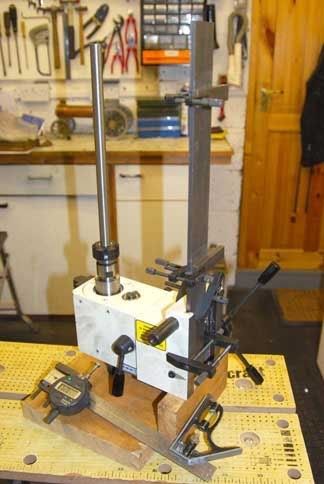Can someone help me to understand what is going on here:-
I have an X2 mill with DROs and when I tried to drill using either of the following methods the hole was consistently to the right of the mark each time by about 0.2mm
1. A centre finder (wobbler) to locate a scribed mark
2. Edge finder to locate the edges and then locate the drill using the DROs
(I have previously used these methods on the same set up with acceptable accuracy)
I am satisfied that both my X and Y DROs are accurate and I have checked the table travel against the graduated hand wheels, the DRO readings and a separate DTI. I am also satisfied that the edge finder and centre finder are accurate (both Starrett). The head and the table are adjusted properly and everything is as rigid as you can expect from an X2. The table is locked for drilling and the DRO readings checked.
I know that the chuck used is not perfect and has some run out but if that was the cause I would expect the result to be random and not consistent. Besides the chuck measures no worse now than when I was getting acceptable results.
I think I have narrowed it down to two centre drills I was using but I am at a loss to work out what is going on. If the problem was due to run out of the spindle, chuck and/or off centre drills then surely the inaccuracy would be random (X and Y) about the desired setting and not consistently just to the right?
Any explanation to get my confidence back into co ordinate drilling would be welcome.
John
I have an X2 mill with DROs and when I tried to drill using either of the following methods the hole was consistently to the right of the mark each time by about 0.2mm
1. A centre finder (wobbler) to locate a scribed mark
2. Edge finder to locate the edges and then locate the drill using the DROs
(I have previously used these methods on the same set up with acceptable accuracy)
I am satisfied that both my X and Y DROs are accurate and I have checked the table travel against the graduated hand wheels, the DRO readings and a separate DTI. I am also satisfied that the edge finder and centre finder are accurate (both Starrett). The head and the table are adjusted properly and everything is as rigid as you can expect from an X2. The table is locked for drilling and the DRO readings checked.
I know that the chuck used is not perfect and has some run out but if that was the cause I would expect the result to be random and not consistent. Besides the chuck measures no worse now than when I was getting acceptable results.
I think I have narrowed it down to two centre drills I was using but I am at a loss to work out what is going on. If the problem was due to run out of the spindle, chuck and/or off centre drills then surely the inaccuracy would be random (X and Y) about the desired setting and not consistently just to the right?
Any explanation to get my confidence back into co ordinate drilling would be welcome.
John






